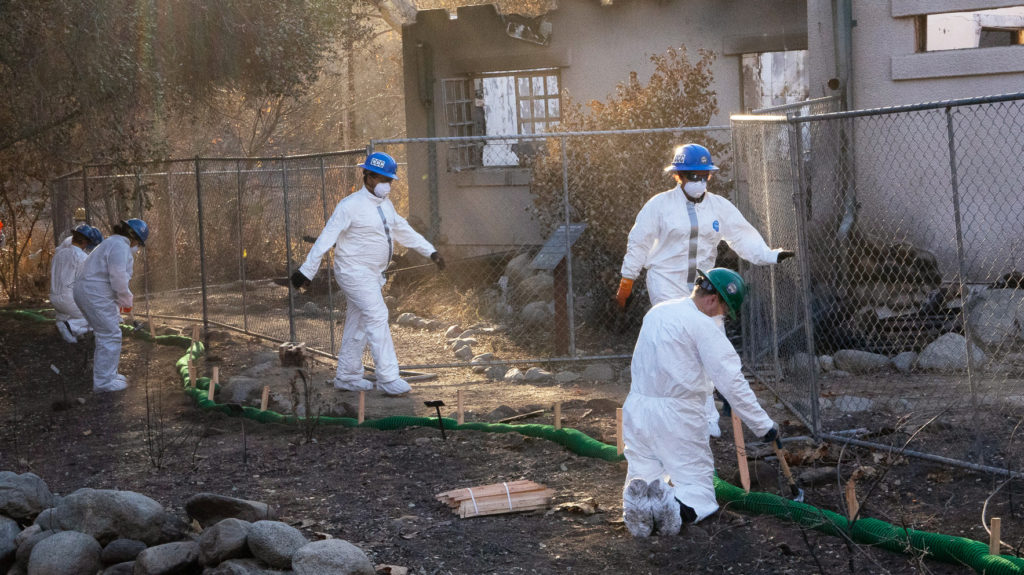
OVERVIEW
After a wildfire, the ash and debris from burned structures contain toxic materials that can potentially runoff into our watershed (creeks, rivers, and waterways) when rainy weather arrives. Toxic materials can result from burned household cleaning products, batteries, or electronics, making watershed protection a critical effort to prevent contaminants from entering our waterways.
California, through the California Governor’s Office of Emergency Services (Cal OES), has tasked over 500 state personnel to conduct the state’s largest watershed protection mission taking place now. These efforts are coordinated by environmental experts, engineers, and emergency management teams.
WHAT STATE AGENCIES ARE INVOLVED?
Cal OES, California Conservation Corps, California Department of Water Resources, CAL FIRE, Caltrans, California Department of Conservation Geological Survey.
HOW DOES THIS WORK LOOK LIKE?
Cal OES has tasked the California Conservation Corps (CCC) [workers in white jumpsuits and hardhats marked “CCC”] to place compost silt socks [long green tube-like material] and other protection material like straw wattles [long burlap tubes] and silt fences around residential and public areas including sidewalks or roads. You may also see these materials around storm drains.
WHERE AND WHY IS THIS WORK HAPPENING?
CCC team members are placing protective materials in the Eaton and Palisades burn scar areas to protect LA’s creeks, rivers, and other bodies of water from toxic runoff. This is essential to protecting aquatic ecosystems, sensitive habitats, and recreational areas, preventing long-term ecological and economic damage.
HOW LONG IS THIS WORK EXPECTED TO TAKE PLACE?
CCC crews began work on January 21, 2025, with work estimated to be completed by mid-February.
DO I NEED TO TAKE ANY ACTION?
Please do not attempt to remove or adjust protective materials. These materials are strategically placed in areas to protect our watershed.
We understand rainy weather is here, please stay informed with weather forecasts and actions you should take to protect yourself or your property in the event of prolonged rain events. Refer to your local public works department for sandbag information and local law enforcement about how to stay safe from threats that prolonged rain can bring.
WHAT OTHER ACTION IS THE GOVERNMENT TAKING?
Rainy weather can bring threats like mudslides or debris flows in burn scar areas, or areas where a fire previously burned. Local government and public works departments are working to install resources like K-rails [cement blocks often used as freeway dividers], muscle walls [plastic barriers], or other protective resources in threatened areas.
Cal OES and other state agency partners are coordinating these resources as they are requested by local government.
TERMINOLOGY
- Watershed: a land area that drains water to a common outlet, like a creek, river, lake, or bay. Watersheds can be small or large and include all the surface water and groundwater in the area. Clean water and healthy watersheds are important for food production, manufacturing, and tourism.
- NOTE: Watershed is not related to public drinking water provided through water treatment plants or drinking water facilities. Treated drinking water is managed by local public works departments.
- Straw Wattles are burlap tubes of compressed straw. They protect slopes, inlets, drains and roadways to reduce soil loss and runoff, and retain sediment. Straw wattles are also used to catch water running Straw wattles are weed-free and are designed to filter water flow. They are flexible and conform to the soil surface.
- Compost Silt Socks are a type of contained compost filter. The filter sock is typically a mesh tube filled with composted material that is used to control erosion and retain sediment. A compost filter sock has an oval or round cross-section and filters sediment and other pollutants (e.g., solids, metals, and motor oil) and allows clean water to flow.
- Silt Fences are made of a filter fabric attached to supporting poles, and sometimes backed by a plastic or wire mesh. The silt fence captures sediment-laden water, allowing water to filter through.
LOCAL & STATE RESOURCE LINKS
